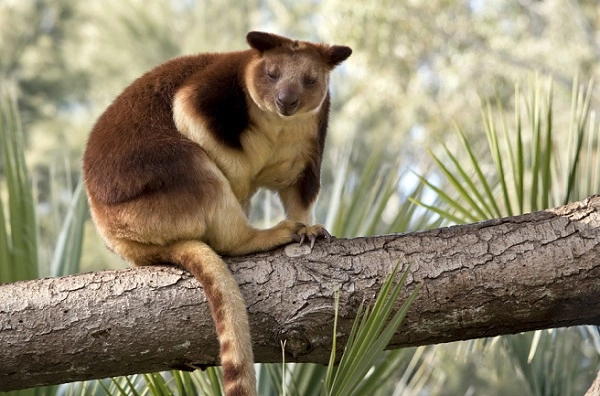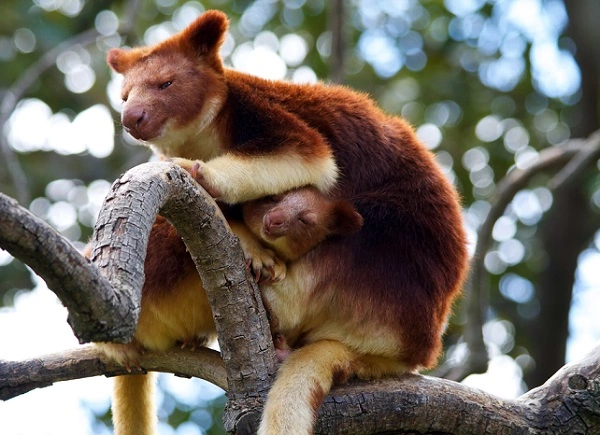As the leaves change color and the days get shorter, many of us are reminded that winter is on its way. For some animals, this time of year means preparing for hibernation. But for others, it’s time to get ready for a long journey. One such animal is the tree kangaroo. Tune in to learn more about these fascinating creatures!

Tree Kangaroo Description
Tree kangaroos are one of the most unique and interesting animals in the world. These unusual creatures are found in the rainforests of Australia, New Guinea, and Indonesia. Tree kangaroos are much smaller than their ground-dwelling cousins, and they have a long tail that helps them balance as they jump from branch to branch. Tree kangaroos are mostly solitary animals, but they will sometimes come together to feed or mate. These fascinating animals are an important part of the rainforest ecosystem, and they play a vital role in dispersing seeds and pollinating flowers. Unfortunately, tree kangaroos are threatened by habitat loss and hunting, and their numbers are dwindling. However, with conservation efforts, it is hoped that these amazing animals will be around for many generations to come.
Tree Kangaroo Habitat
Tree kangaroos are found in the forests of Australia, Indonesia, and Papua New Guinea. They are arboreal, meaning that they spend most of their time in trees. Tree kangaroos are well-adapted to life in the canopy, with strong claws that help them climb and a long tail that acts as a counterbalance. In addition to trees, tree kangaroos also inhabit shrubs, vines, and bushes. Tree kangaroos are mostly nocturnal animals, coming down from the safety of the trees at night to feed on leaves, fruits, and flowers. Although they are capable of swimming, tree kangaroos prefer to live in areas where there is a reliable source of fresh water. Tree kangaroos are solitary animals, but they will sometimes congregate in small groups to feed or sunbathe.
Tree Kangaroo Diet
Tree kangaroos are found in the tropical rainforests of New Guinea, Indonesia and far north Queensland in Australia. They are unique among marsupials in that they live largely in trees, coming down to the ground only to move between trees or to feed. Tree kangaroos are folivores, which means that their diet consists mainly of leaves. However, they are also known to eat fruits, flowers, bark and occasionally small animals such as rodents or birds. Tree kangaroos obtain most of the water they need from the plants they eat, but will also drink from streams and pools if available. Tree kangaroos are mostly active during the day, although they may be more active at night in areas where there is human activity during the day.

Tree Kangaroo Size
Tree kangaroos are found in the rainforests of northern Australia, Indonesia, and New Guinea. They are the largest of all kangaroos, with an average length of 2.5 meters from nose to tail and a weight of up to 90 kg. Tree kangaroos have long, strong hind legs that they use for leaping from tree to tree. Their front legs are shorter and weaker, and are used for gripping branches and climbing. Tree kangaroos have dense fur that is grey or brown in color, and a long tail that is used for balance. They are able to Glide up to 30 meters between trees using their tail as a rudder. Tree kangaroos are shy, solitary animals that spend most of their time high in the forest canopy. They are mainly active at night, when they descend from the trees to feed on leaves, shoots, and fruits. Tree kangaroos are endangered due to habitat loss and hunting. There are thought to be less than 10,000 individuals remaining in the wild.
Tree Kangaroo Lifespan
Tree kangaroos are one of the most unique and interesting animals in the world. These marsupials are found in the rainforests of Australia, Indonesia, and Papua New Guinea. Tree kangaroos are an important part of the ecosystem because they help to disperse the seeds of the plants they eat. Tree kangaroos are also a key prey species for predators such as dingoes and pythons. Tree kangaroos have a relatively long lifespan for marsupials, living an average of 12 years in the wild and up to 20 years in captivity. Tree kangaroos are a fascinating animal and play an important role in their ecosystem.
Tree Kangaroo Behavior
Tree kangaroos are marsupials that are found in the rainforests of Papua New Guinea, Indonesia, and northern Australia. They are the largest members of the kangaroo family and can grow up to four feet long and weigh up to 50 pounds. Tree kangaroos are very shy animals and are most active at night. During the day, they sleep in the trees or in hollow logs. Tree kangaroos are excellent climbers and jumpers and can leap up to 30 feet from one tree to another. Tree kangaroos eat mostly leaves, fruit, and flowers, but they will also eat insects, birds’ eggs, and small mammals. Tree kangaroos are endangered due to deforestation and hunting.
Tree Kangaroo Speed
Tree kangaroos are one of the many marsupial species found in Australia. Tree kangaroos are marsupials of the genus Dendrolagus, and they mostly live in trees. Tree kangaroos look somewhat like a cross between a small kangaroo and a lemur, and they are excellent climbers. In fact, tree kangaroos are considered to be some of the best climbers among all marsupials. Tree kangaroos are also interesting in that they have one of the highest levels of vertical jump among all mammals. Tree kangaroos can reach speeds of up to 35 km/h (22 mph) when leaping from tree to tree.
Tree Kangaroo Hunting
Tree kangaroos are native to the tropical forests of Australia, Indonesia, and Papua New Guinea. They are the largest members of the kangaroo family, and their long tails and sharp claws give them an appearance that is more similar to a monkey than a kangaroo. Tree kangaroos are also excellent climbers, and they often spend most of their time high in the treetops. Due to their rarity and their ability to elude humans, tree kangaroos have become something of a trophy animal for hunters. Although tree kangaroo hunting is not currently regulated, there is growing concern that it may lead to the species’ extinction. Tree kangaroos are already listed as endangered, and experts estimate that there are fewer than 10,000 individuals remaining in the wild. If action is not taken to protect them, tree kangaroos could be extinct within our lifetime.
Conclusion
The tree kangaroo is an elusive creature that can be found in the rainforests of Australia and New Guinea. These marsupials are shy and prefer to stay high up in the trees, making them difficult to study and observe. Despite their reclusive nature, researchers have learned a great deal about these animals thanks to new technology and advances in science. What we know so far is that tree kangaroos are important members of their ecosystems and play a critical role in forest health. They are also fascinating creatures with remarkable adaptations that allow them to live in some of the most challenging environments on Earth.
Frequently Asked Question

